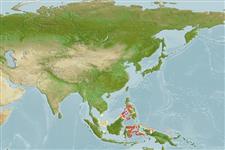| Native range | All suitable habitat | Point map | Year 2100 |

|
| This map was computer-generated and has not yet been reviewed. |
| Ecsenius dilemma AquaMaps Data sources: GBIF OBIS |
Utilisations par l'homme
Aquarium: Commercial
Phylogenetic diversity index
(Ref. 82805)
PD50 = 0.5000 many relatives (e.g. carps) 0.5 - 2.0 few relatives (e.g. lungfishes)
Niveau trophique
(Ref. 69278)
2.0 ±0.00 se; Based on food items.
Résilience
(Ref. 69278)
Haut, temps minimum de doublement de population inférieur à 15 mois (Preliminary K or Fecundity.)